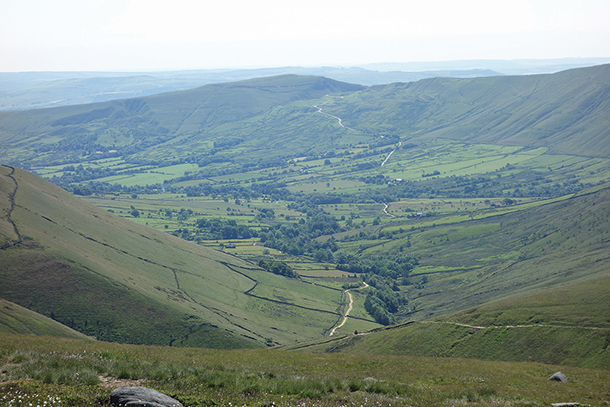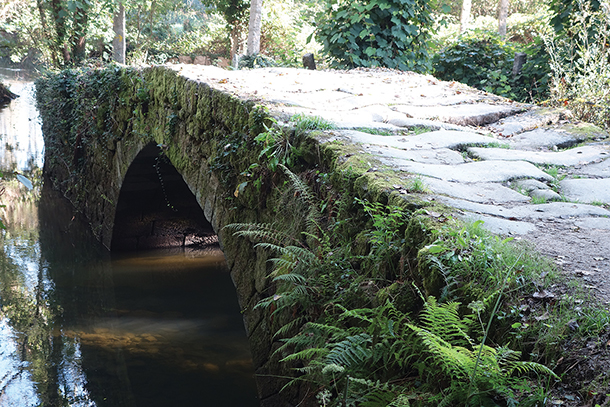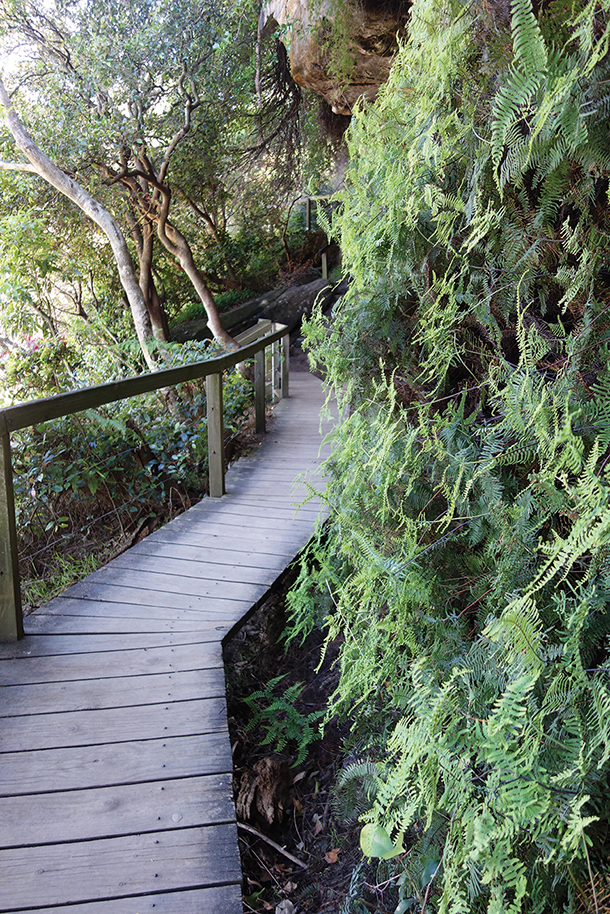Walks of a Lifetime: Extraordinary Hikes From Around the World
Air Date: Week of September 1, 2017

A hiker follows a path in the Maroon Bells-Snowmass Wilderness, along one of the walks featured in Walks of a Lifetime. (Photo: Bob & Martha Manning)
Bob and Martha Manning have walked thousands of miles together, through wilderness and dense cities, on hiking trails and along sacred pilgrimage paths. Their 2017 book Walks of a Lifetime brings together thirty favorites from around the world, with walks for beginners as well as experienced hikers. In this conversation with host Steve Curwood they explain their tips for fellow trekkers and the benefits and surprises of seeing the world on two feet.
Transcript
CURWOOD: Walking is the basic way humans get around, and though it’s not the fastest means of travel, it is a favorite. Even for the casual walker, it’s an unparalleled way to immerse oneself and truly experience a place – whether wilderness or urban.
A new book, "Walks of a Lifetime," aims to tantalize the armchair ambler and the would-be hiker with descriptions of thirty walks of varying length and difficulty, all over the world. Bob and Martha Manning are the authors, and they’ve logged thousands of miles on hikes of various lengths. And they’re on the line now.
So, Bob, let me start with you. How did you two get into long-distance walking?
BOB: Well, Steve, we've been pretty active most of our adult lives, visiting national parks and doing a lot of hiking, but about 15 years ago or so, we were living in Vermont, and Vermont has a long trail that's aptly named the Long Trail. It was the first long distance trail in the United States, and Martha and I decided to walk it. We did it in sections and ,after we finished, we just felt so good about it, and we enjoyed it so much that we began to look around for other long distance trails and found them, not only lots of them here in North America, but really all around the world, and we've been kind of obsessive about it lately.
And I guess about four or five years ago we decided that we really wanted to try and encourage other people to walk more in their everyday lives and consider doing some long distance walking, and so we started to write about some of our walks.
CURWOOD: Let me ask you, Martha, in your book you feature several essays on topics like the health of walking, the ethics of walking, and the “journey” versus the “destination” aspect of walking. Talk to me about those.

Between countries, walkers have different rights when it comes to rights of way. Above, a view of the Kinder Scout area in England, where in 1932 hundreds of walkers asserted their “right to roam;” unlike the U.S., walkers in the U.K. are generally allowed to cross private property. (Photo: Bob & Martha Manning)
MARTHA: Well, there's more to walking than just going out and putting one foot in front of the other. We thought it was important that people think about why they walk and the many dimensions that walking has and how enriching walking can be. And when you're talking about journey versus destination, for example, we used to be pretty goal oriented, that we wanted to get from point A to point B and then B to C and so forth, but we found that the more we walked, the more we were able to really relax into the experience itself, and that oftentimes, for example, on the religious pilgrimages, the walk itself became more important than the destination. And it's important for people to realize things like that that there are many benefits to walking. There are things they ought to be thinking about as they're partaking in this wonderful activity.
CURWOOD: At one point in your book you have this essay that you entitle "Sitting is the new form of smoking". What do you mean, Bob?
BOB: [LAUGHS] I think among the many benefits of walking, we're really recognizing now that health is certainly one of them. I think that we're experiencing an epidemic of obesity in the United States and elsewhere around the world. Many people have sedentary lifestyles, and walking is a way to really enrich your life in terms of physical and even mental health. There's imperical evidence to back this up from both a mental and physical health standpoint. So, walking for us can be a happy activity, one that we really enjoy, and it's got this added benefit of increasing our health as well.
CURWOOD: And what about the spiritual part? You said that there are these physical benefits. There's the mental health benefits. And what about connecting with the spiritual part of yourself?
BOB: Martha and I have walked several religious pilgrimages, routes that people have been walking, really, for 1,000 years or more, mostly for spiritual reasons. I think we weren't walking them for religious purposes, but I think actually we found that they maybe do have a spiritual dimension, even for non-religious people. They're an opportunity to really think about things that are important, to get away from the distractions of everyday life and to focus on things that are, you know, vital.

The Needles area in Utah is a rugged landscape, but trails help provide a safe as well as stunning journey through its red-rock canyons and stone arches. (Photo: Bob & Martha Manning)
MARTHA: When you're out there and the distractions of your home day-to-day life have been stripped away, all you're thinking about is getting from, getting along the trail, getting to the end point of the day, you take time to breathe deeply and relax into the experience to which you're passing, and then you look around at what you're passing through, and that's where the spiritual dimension came to me. I mean, sometimes it's a wonderful landscape that you're passing, but sometimes it's just knowing the passage of people through that landscape over such eons that affected me spiritually.
CURWOOD: Martha, which one of these religious pilgrimages did you find resonated the most with you spiritually and why?
MARTHA: I would say the El Camino de Santiago across northern Spain. It's 480 miles from the Pyrenees border with France to Santiago de Compostela in western Spain, and I expected it to be a very historical, a very interesting walk, and it certainly was, but you couldn't escape the spirituality. When you see places that are worn from the passage of pilgrims over a 1,000 years, you can't help but sense that other dimension that is there for so many people, and we chose to do the whole thing, but people do sections of it and come away with the same sensation.
CURWOOD: So, to what extent do different countries and regions have different conceptions of where walkers are allowed to roam?
BOB: You know, there is quite a difference and certainly in Europe. That's where we discovered a very different culture of walking. Walking is embedded more directly and more deeply into the cultures of many of the European countries and some other countries as well.
In the United States, I think certainly we have a history of doing a lot of hiking, but it's not so widely adopted as it is elsewhere. In Europe, for example, you're allowed in many cases to walk across private lands. Many of the trails perhaps even most of the trails are on private lands and that's well accepted phenomenon, very different than the United States, where we rely primarily on public lands.

The Great Wall of China is one of the “Walks of a Lifetime” the Mannings include in their new book. The “wilderness” section of the wall can present a significant physical challenge to walkers, as the way is rough and very steep in places. (Photo: Bob & Martha Manning)
CURWOOD: Martha, in the book there are number of walks that you outline in wilderness areas out away from everything, but you also talk about the value of urban walks. Talk to me about that now.
MARTHA: Well that's been a real surprise for me. We are not urban people, but we have begun to appreciate the joys of walking in urban environments, and we've walked both in Europe and Australia and in the United States and have found these urban walks to be really delightful. They’re a wonderful way to learn about a city and to really appreciate a city.
An example I might give you is the Great Saunter around the island of Manhattan in New York City. We lived in Vermont and were a little bit intimidated by the whole idea of New York City, but, walking around the very shoreline of the island of Manhattan, we learned to appreciate the different boroughs that we went through. We learned to appreciate the rivers - the Hudson, the Harlem, and the East rivers - and we learned to appreciate the diversity of people that populate New York City. It was just a thoroughly delightful experience.
We also have spent several days in Sydney and in Paris, walking out where the locals walk, and there's really no better way to learn a city. When we were in Paris, we never went in any of the museums. We walked all day, every day and came away feeling that we had appreciated that Paris is the museum itself, that we didn't need to go inside anywhere.
CURWOOD: Well, and, indeed, it goes back to the health angle, then, walking in Paris because you go by all those bakeries where you can just smell the fresh croissant and all the stuff that they serve up, but if you want to eat any of that, I guess you better walk it, huh?
MARTHA: Well, if you walk it, you can eat anything you want. [LAUGHS] That's the real benefit of walking.
CURWOOD: Martha what's it like to walk as a couple? You guys have been married how long?
MARTHA: We've been married for 49 years, and we find that walking is a real highlight of our lives together. We enjoy planning the walks. We enjoy doing the walks. We enjoy reliving the walks, and we have really gotten a lot of satisfaction out of writing these books and finding that we're encouraging other people to go out. It's really a gift to us, and I think they look at us, Steve, and they say, “Well, if they can do it, I can do it,” and they give it a try. But you certainly don't have to be a couple because there are all kinds of hiking organizations that provide walks in neighborhoods and communities, worldwide organizations. There are companies that match up people. Singles can come into groups. You need certainly don't have to be a couple to get a lot out of a walk.

The stones of this ancient bridge on the Camino Portugués have been worn by centuries of pilgrims heading to Santiago de Compostela. (Photo: Bob & Martha Manning)
BOB: I found it amusing one day when Martha came home from having lunch with some of her women friends, and she said her women friends were asking her, “What do you two talk about all the time?” and I just thought that that was funny. You know, first of all, we don't talk the whole time we're hiking, but secondly it is an opportunity to talk about the things that are really important to us. You know, our family and our future and the values that we have and where we want to go on on our next hike. I mean, all these things are...maybe we don't have a lot of time to talk about them during the hecticness of our everyday lives, but the walks give us an opportunity to focus on these things that are more fundamental.
CURWOOD: Tell me, who do you see when you're out on the trail? Are they fairly well-to-do, white, educated couples such as the two of you, or, well, who do you see?

Walks of a Lifetime features trails suitable for experienced hikers as well as paths that look like the gentle Australian boardwalk above, for people who want or need a more leisurely walk. (Photo: Bob & Martha Manning)
BOB: It's a great diversity, and it has a lot to do with where we're walking. And that's one of the things that's made the urban walking a nice addition to our experiences, a nice addition to our portfolio of walks, if you will.
We have a daughter in Los Angeles and we go to visit her regularly, and we've done some walking in the Santa Monica Mountains National Recreation Area along a trail called the Backbone trail, a wonderful 60-some-mile trail that goes right into Los Angeles. There we see such a wide diversity of people, people of different ages, people of different races and ethnicities. That's been really very refreshing and why we've wanted to include urban walks in our newest book. I think it helps to sort of democratize long distance walking. It is possible to do that in urban regions, and hopefully, ultimately that might translate into walking into some more wild areas as well.
MARTHA: And I have to say in Europe you see people of all ages out walking, more so than you do in the United States. And one thing that has been a real joy for us to realize is that, universally, we found people to be lovely, and, if you're a walker, you're a walker. It doesn't matter what country you come from or what religion you have, or anything else. All that falls away and you talk about your experiences that you have in common rather than the experiences that separate us.
CURWOOD: So, for people who aren't particularly experienced in walking and hiking, what trail would you recommend that they possibly start with?
BOB: Well, I've got a couple of ideas about that, Steve. I think, first of all, I would suggest walking in your hometown, walking around in your neighborhoods. If you're fortunate enough to be able to walk back and forth to work, that's a great place to start, or to walk down to the grocery store instead of driving, or just go for an evening walk around the neighborhood. I think our books are about encouraging people to walk more in their everyday lives and then considering long distance walks. We've deliberately tried to offer a spectrum of opportunities.
I think that the carriage road system in Acadia National Park would be just the ideal place to start. It's the, really a very non-demanding but beautifully sited and managed 50-mile network of carriage roads, non-motorized roads, that one can walk around and really see Mount Desert Island, not only see it but really experience it, to hear it, to smell it, to go to Jordan Pond house for tea and taste it at the same time, and that's a good one to start with, but there are lots of other examples as well.

One central joy of walking is the intimate exposure to the local culture and everyday life. On the Amalfi Coast, the Mannings’ walks brought them into contact with the unique architecture, horticulture, and cuisine of this ancient place. (Photo: Bob & Martha Manning)
MARTHA: And we find that the more you hike in areas that are familiar and comfortable to you, the more confident you get in your abilities, the more you're going to enjoy when you're out in an unfamiliar environment where things are perhaps a little more challenging. You know that you can do the distance because you've been doing it locally.
CURWOOD: And by the way, how many miles have you walked now in your walking career?
BOB: Oh my goodness, I wish we'd started keeping track at the very beginning, but I took a look through the two books that we've written about long distance walking, and they total a little over 6,000 miles.
MARTHA: We figure, by the time we add in all the walking that we do to get ready and the walking we do just go visit the neighbors and that sort of thing, we’ve probably walked tens of thousands of miles. But I don't regret a single mile.
CURWOOD: OK, so how many pairs of walking shoes do you go through in a year?
BOB: Oh my goodness.
MARTHA: Numerous.
BOB: Yes, maybe a half a dozen pairs, anyway.
MARTHA: And if you look in our closets, we have our assortment of walking shoes, and then we have a few pairs of real shoes in there because normally we wear our walking shoes because you never know when you might get an opportunity to go for a little walk.
CURWOOD: Bob and Martha Manning are authors of the new book, "Walks of a Lifetime". Thanks so much for taking the time with me today.
BOB: You're welcome.
MARTHA: Happy trails.
Links
Walks of a Lifetime: Extraordinary Hikes from Around the World
Living on Earth wants to hear from you!
Living on Earth
62 Calef Highway, Suite 212
Lee, NH 03861
Telephone: 617-287-4121
E-mail: comments@loe.org
Newsletter [Click here]
Donate to Living on Earth!
Living on Earth is an independent media program and relies entirely on contributions from listeners and institutions supporting public service. Please donate now to preserve an independent environmental voice.
NewsletterLiving on Earth offers a weekly delivery of the show's rundown to your mailbox. Sign up for our newsletter today!
 Sailors For The Sea: Be the change you want to sea.
Sailors For The Sea: Be the change you want to sea.
 The Grantham Foundation for the Protection of the Environment: Committed to protecting and improving the health of the global environment.
The Grantham Foundation for the Protection of the Environment: Committed to protecting and improving the health of the global environment.
 Contribute to Living on Earth and receive, as our gift to you, an archival print of one of Mark Seth Lender's extraordinary wildlife photographs. Follow the link to see Mark's current collection of photographs.
Contribute to Living on Earth and receive, as our gift to you, an archival print of one of Mark Seth Lender's extraordinary wildlife photographs. Follow the link to see Mark's current collection of photographs.
 Buy a signed copy of Mark Seth Lender's book Smeagull the Seagull & support Living on Earth
Buy a signed copy of Mark Seth Lender's book Smeagull the Seagull & support Living on Earth

